PayPal has reported solid Q3 2024 results amid its ongoing transformation project, and is signalling an increasingly global focus. But what is the role of its P2P payments brands, including Xoom and Venmo?
Alex Chriss, CEO of PayPal, is now one year into the job, and his transformation plan for the brand is already underway and showing early improvements.
Focusing on shifting the brand “from a payments company to a commerce platform”, as Chriss put it in PayPal’s Q3 2024 earnings call, the company has made several key product improvements designed to improve its competitive offering, and has also announced a number of partnerships with major companies.
However, there is still far more to come, and much of the company’s potential comes not from its core US market – although it is still looking to innovate in the country – but from abroad, with Chriss highlighting that “PayPal has a massive global opportunity” ahead of it.
While much of the focus has been on its commerce offering, the company’s P2P payments products, which include PayPal P2P payments, US-focused P2P payments app Venmo and remittance-focused Xoom, are also seeing an increasing focus. Xoom, in particular, is receiving increased investment and attention from PayPal after years of deprioritisation, while the company is also looking to expand the capabilities and reach of Venmo.
With this in mind, what are the global opportunities for PayPal, and what role does its P2P payments offering play? We take a look, aided by its Q3 2024 results and beyond.
PayPal’s Q3 2024 performance and future projections
PayPal hailed positive top-line results in Q3 2024, with the company seeing net revenues climb 6% YoY to $7.8bn – its strongest ever Q3 and its second strongest quarter after Q4 2023.
This was in line with the company’s previous-quarter projections of “mid single-digit growth”, although was slightly behind analyst expectations. Its operating margin was also the strongest for a Q3 since the pandemic, at 17.7%, and the company also reported an 8% rise in transaction margin dollars to $3.7bn, in part due to increased interest in customer balances.
However, the company’s Q4 2024 revenue expectations are more muted, with PayPal projecting “low single-digit growth” for the following quarter. It says this is partly the result of deferring marketing expenses from the first half of the year, although operational expenditure when normalised across the year is expected to only be up by single digits on 2023. It did, however, raise its FY guidance for earnings per share and transaction margin dollars.
The Q4 projections are likely to translate into Q4 net revenue of around $8.2bn, meaning full-year revenue would be around $31.6bn – a 6% increase on 2023 and its lowest YoY increase for full-year revenue to-date.
While the company has not provided formal FY 2025 guidance, earnings call comments from CFO Jamie Miller also indicated low single-digit rises in operational expenditure, while the company anticipates a greater positive impact on revenue from renewals “over the next several quarters” and the company is also anticipating gains in margin over the next few years as it negotiates contracts with existing customers.
The more muted Q4 projections were below analyst expectations and, combined with the below-expected Q3, prompted a negative market reaction, causing share prices on the day of publication to close almost 4% down on the previous day
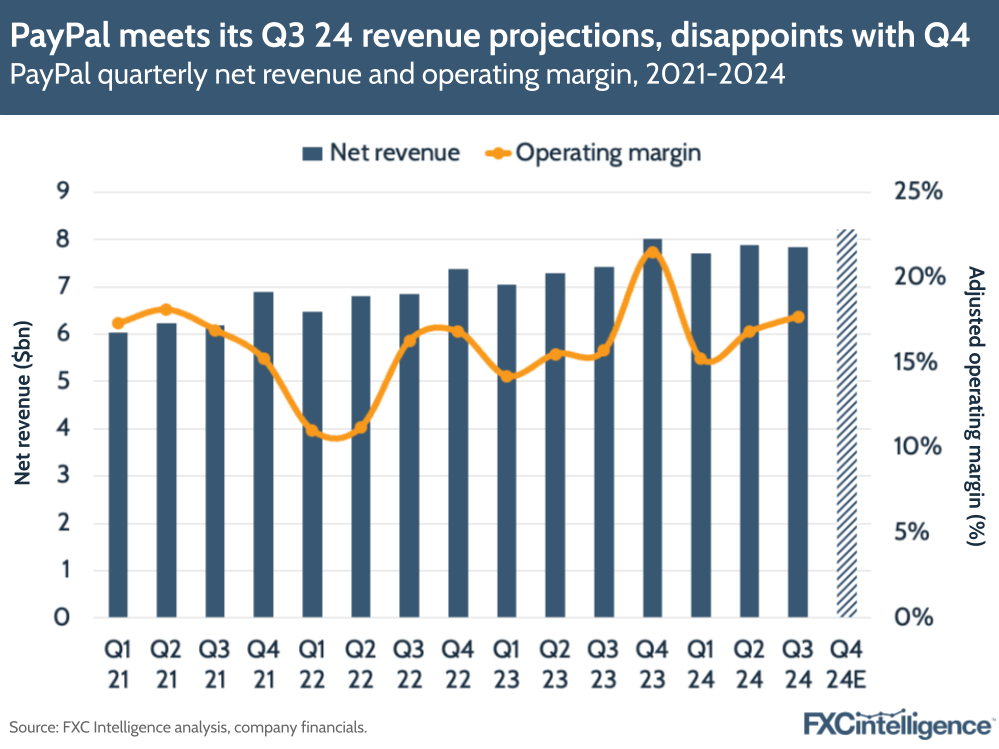
Meanwhile, total payment volume (TPV) was up 9% YoY to $423bn, buoyed by a 6% increase in payment transactions to 6.6 billion in the quarter. This represents an average transaction value of around $64 – a 3% increase on Q3 2023.
However, this TPV also means the company’s take rate for the quarter was 1.86% – a metric that has been slowly but steadily falling since the end of 2022 and that is currently at its lowest level, having reduced by five basis points from Q3 2023.
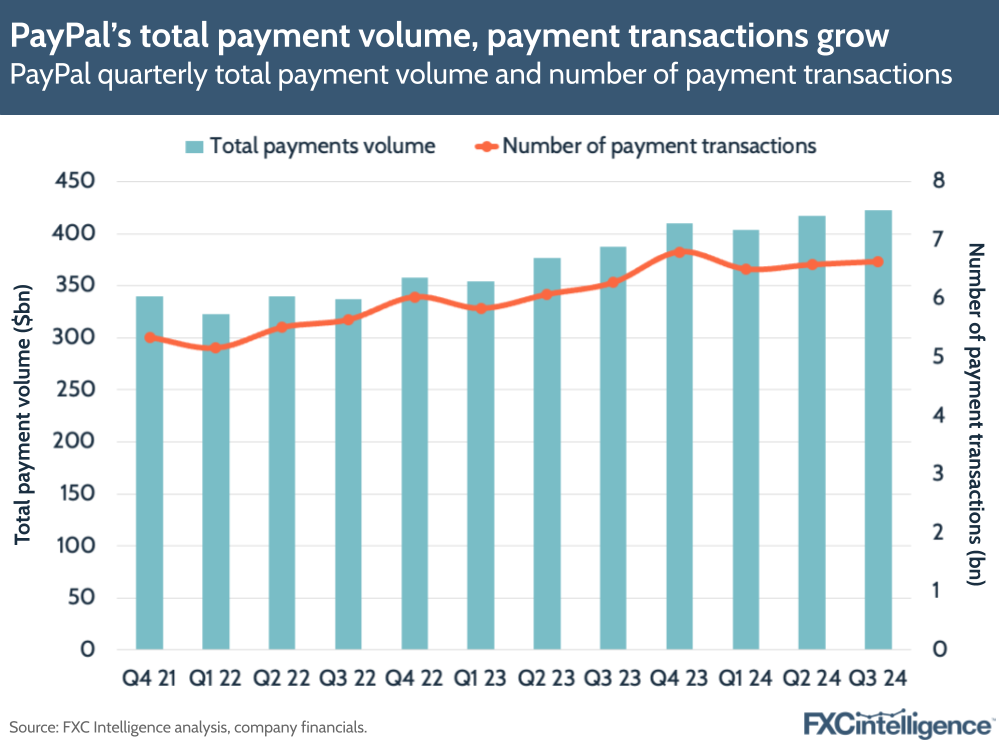
On active customers, the company is continuing to show signs of improvement after a sustained run of decline in active accounts, which are defined as those with at least one transaction in the preceding 12 months, across 2023.
In Q3 2024, PayPal saw its strongest increase in active accounts in two years, with active accounts rising to 432 million – only slightly below Q1 2023 levels. It has also seen a rise in active accounts with at least one transaction in the last month, which grew to 223 million, around five million up on Q3 2023.
Transactions per active account have also increased slightly, rising by 8.5% YoY to 61.4 – the highest this has been for the company over the past few years.
However, excluding transactions from PayPal’s unbranded card processing, which is supplied through its Braintree brand, the rate was a much lower improvement on previous quarters – at 34.5 transactions per active account, representing a 5% YoY increase.
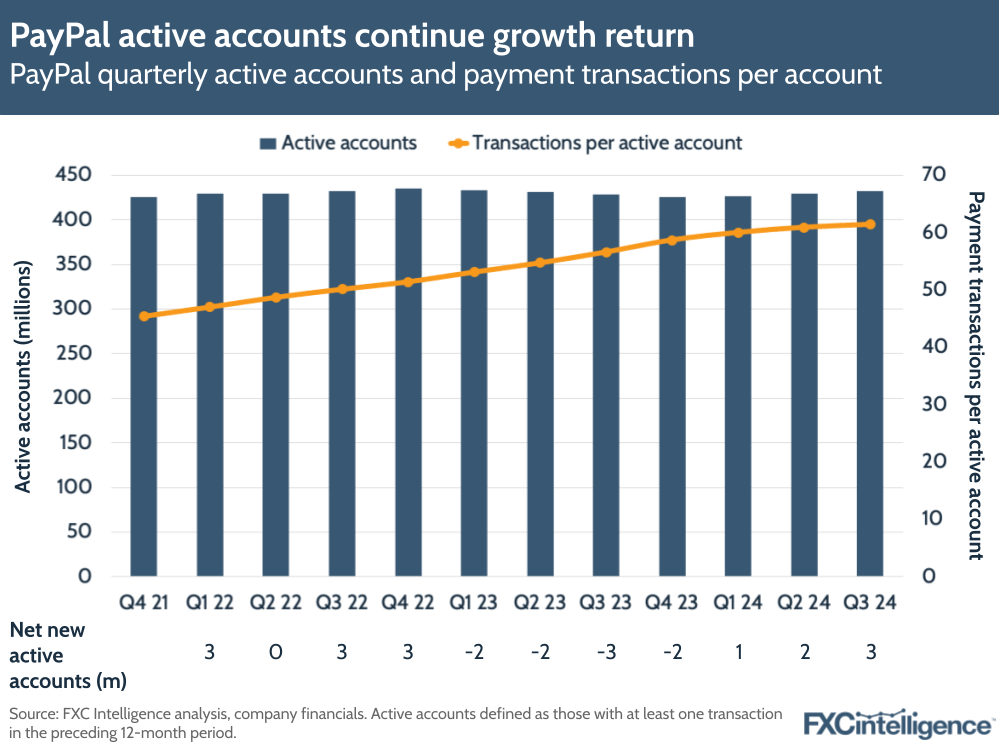
Cross-border’s impact for PayPal
Looking to cross-border payments, PayPal does not break out revenue along these lines, but does publish TPV for cross-border transactions, which covers both purchases made cross-border and money sent via its remittances brand Xoom. In Q3 2024, cross-border TPV climbed by 7% YoY on an FX-neutral basis to reach $50.2bn; the company has seen this metric grow by more than 5% for the last four quarters.
The company cited intra-European corridors as a key driver of this, although as these will largely involve a single currency in the euro, they are likely to present a lower opportunity for revenue generation than cross-border transactions requiring a currency conversion.
The pace of cross-border TPV growth also has not matched other areas for PayPal’s TPV, leaving cross-border to take a declining share over the past few years. While at the start of 2018 cross-border payments accounted for 20% of TPV, in Q3 2024 they were only 12%.
Despite this, metrics from the past four quarters suggest that this share is broadly stabilising, with Q3’s share a few basis points higher than Q2 2024, and all of the last four quarters remaining within 20 basis points of each other.
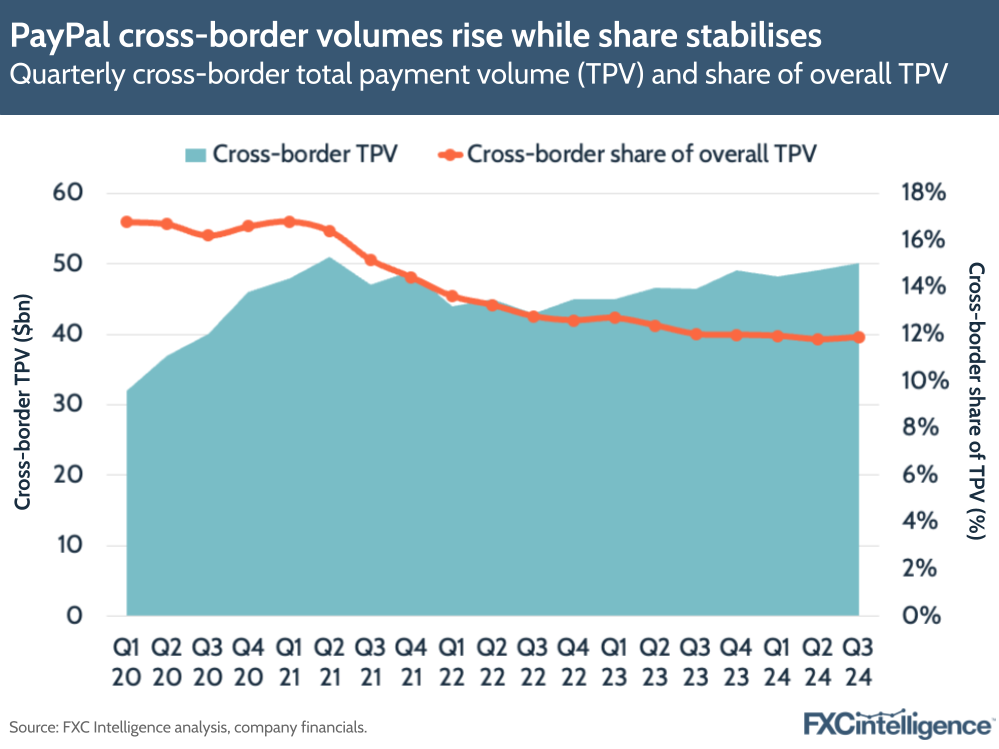
Nevertheless, it is clear that cross-border payments have been a lower priority for PayPal of late, garnering few mentions in earnings calls and none in the most recent call.
At present, much of PayPal’s focus has been on overhauling its commerce offering starting with the US, including through recently launched solutions including Fastlane by PayPal, a streamlined guest checkout experience and rewards platform PayPal Everywhere. Launched in the US in September 2024, this is designed to encourage use across in-person retail and ecommerce, aided by a debit and cashback Mastercard.
This US focus is likely to have ensured cross-border is a lower focus for the company, particularly given the lower rates of cross-border purchases among US consumers than in some areas of Europe, for example.

The global opportunities for PayPal
The US-centric nature of PayPal at present was also evident in the partnerships highlighted in the earnings call. All announced in recent months, these are for the most part extensions of existing partnerships to broaden where PayPal can be used and to increase the availability of Fastlane.
However, all the partnerships, which are with leading players including Adyen, Amazon and Shopify, are specifically focused on enhancing capabilities in the US.
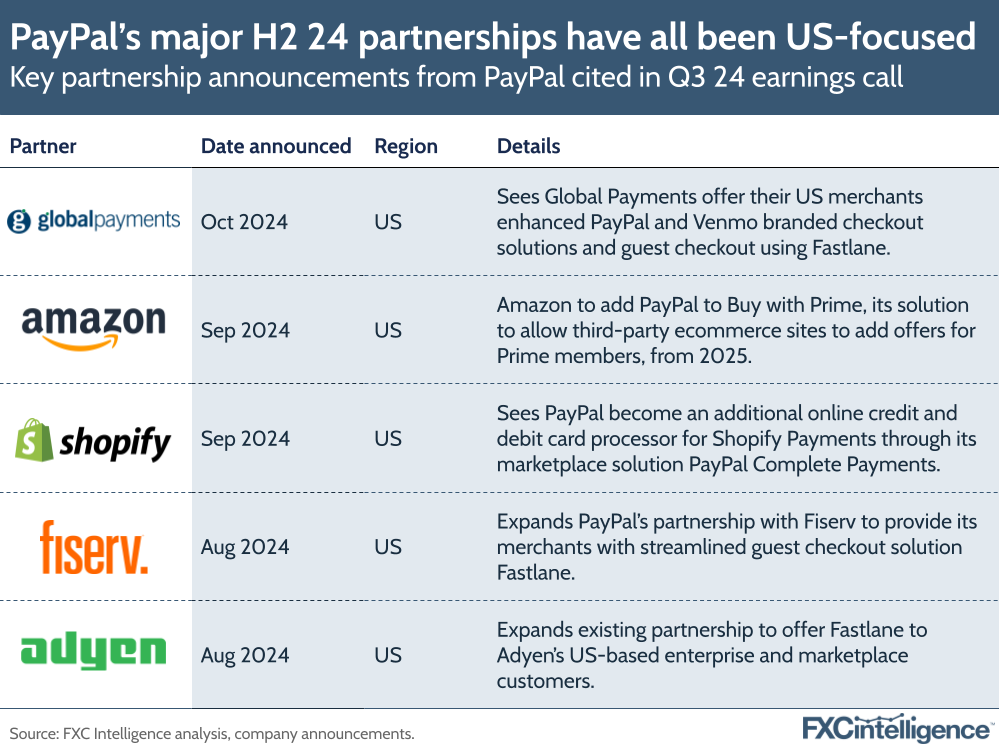
This is perhaps unsurprising. The company reported 58% ($4.5bn) of its Q3 2024 revenue being from the US and does not break out any other regions, reporting all remaining revenue as “International”, which totalled $3.3bn for the quarter.
This share has remained relatively static since Q1 2023, although US revenue rose at a slightly faster rate in Q3 2024, at 6.1% compared to International’s 5.3%.

On TPV, the US share is even more pronounced, at 63% in Q3 2024, for a total of $266bn, compared to International’s $157bn. International share has also remained relatively flat, at around 37%.
US TPV grew at a slightly faster rate than International in Q3, at 9.5% compared to 8.2% for International, where the company cited “continued strength in Europe”.
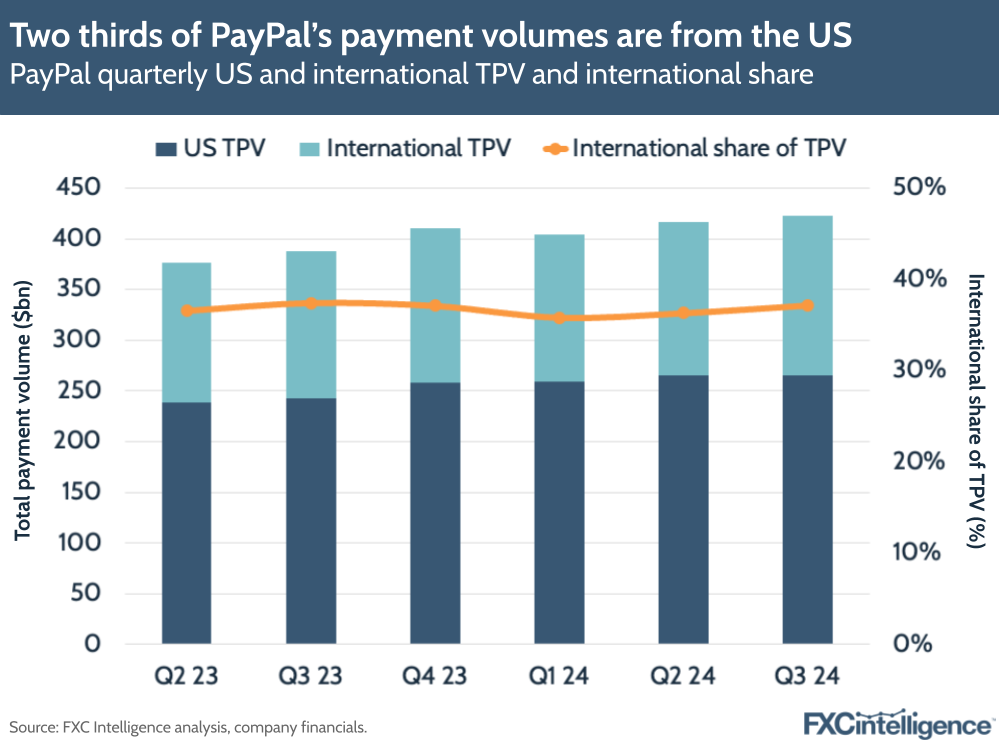
Despite the clear US focus at present, there is a strong case for much of PayPal’s future growth being beyond its home market, and there are some signs that the company is beginning to recognise this.
In addition to citing the global nature of the opportunity ahead for PayPal, Chriss also highlighted international merchants as a key driver of strength in its branded checkout platform and said that the company continues to “forge important partnerships with leaders in global commerce”.
There are also clear plans for further growth internationally The company launched its small and medium-sized business solution PayPal Complete Payments in several new geographies in September, including China and Hong Kong, and plans further market launches in 2025.
Meanwhile, it also plans a launch of PayPal Everywhere in Europe in 2025, where it anticipates NFC capabilities will be key to driving adoption.
P2P payments at PayPal
While PayPal continues to highlight its focus on shifting to being a commerce platform, Chriss’ transformation efforts have included signs that the company is increasingly looking to grow all aspects of its P2P payments offering.
This consists of three brands: P2P payments within PayPal itself, where users can send money between PayPal accounts both domestically and cross-border; Venmo, its US-only domestic P2P payments brand; and Xoom, its cross-border remittances brand.
Cross-border P2P payments, and particularly Xoom, had been significantly deprioritised at PayPal during and in the aftermath of the pandemic, as the company focused on surging ecommerce demand. However, it has regained renewed focus, and this year PayPal began to publish TPV metrics related to P2P for the first time.
These are primarily published as P2P excluding Venmo, which covers PayPal P2P and Xoom, and Venmo, accounting for 8% and 18% of all TPV respectively in Q3 2024 – a share that has remained relatively flat for the past few quarters. This means that together, domestic and cross-border P2P payments account for slightly over a quarter (26%) of all of PayPal’s TPV.
Combined, PayPal reports P2P TPV of $102bn in Q3 2024, with a YoY growth rate of 6%.
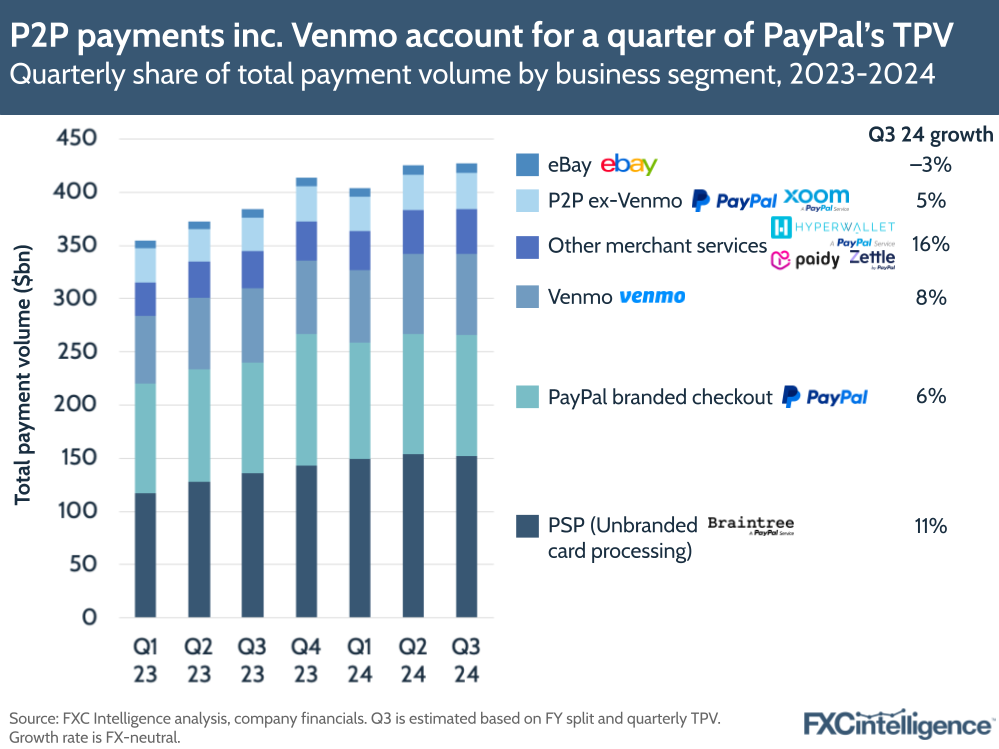
Xoom’s redevelopment and PayPal P2P payments
Looking to Xoom and PayPal P2P, the share has consistently remained under 10% of all TPV and has remained at 8% for the last six quarters, with Q3 2024 TPV being around $34bn.
However, how much of this is assigned to each brand is not entirely clear. PayPal does say that P2P excluding Venmo TPV “primarily comprises PayPal P2P volume, with some contribution from Xoom”, although has not provided any further details on the split between the two.
The company did report 5% YoY growth in this segment on an FX-neutral basis, which while lower than TPV overall is a strong sign. This represents the strongest YoY growth across the period PayPal has published results for (Q1 2023 to Q3 2024), and the fourth quarter where growth has been positive.
This reflects indications that the company is increasingly investing in P2P payments, particularly on the Xoom side, under Chriss’ leadership. However, at present, the focus appears to have been in growing engagement from current customers, with PayPal reporting increased engagement among its existing user base as key to driving growth in the quarter.

There are also indications of an increased focus from discussion of P2P, and to a lesser extent Xoom, within the company’s earnings calls. While Xoom saw discussion at the start of the year, and has received mentions in supporting documents throughout this year after no mentions since the pandemic, P2P has seen a more consistent upswing in mentions in 2024.
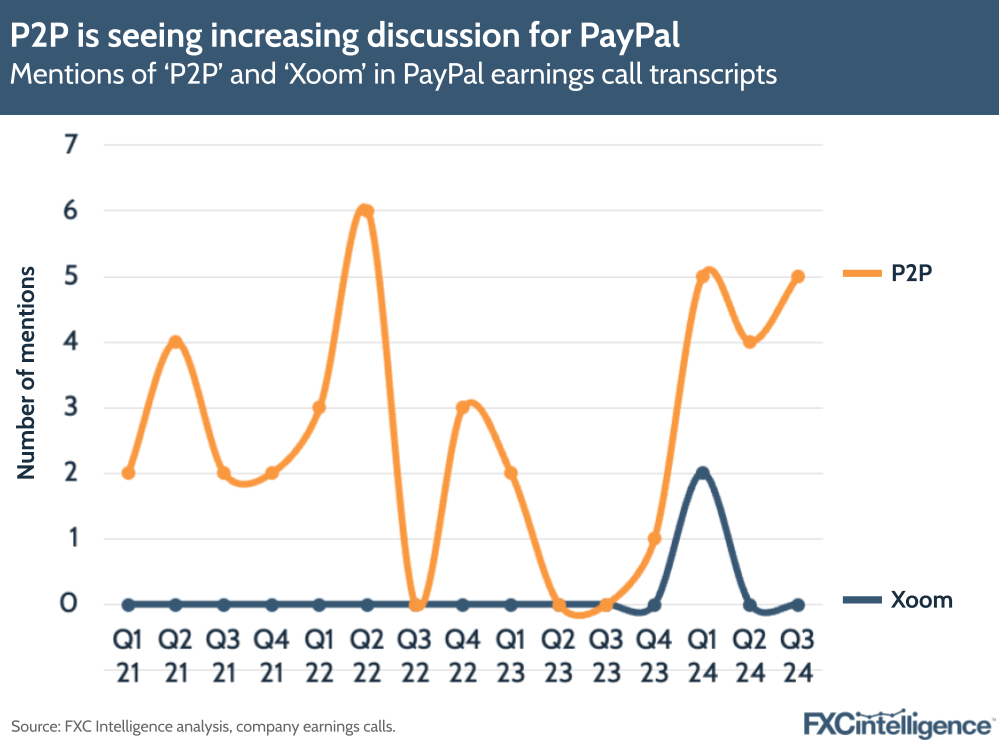
For Xoom, the turnaround is likely to take some time, and we are unlikely to see notable metric changes for some time, which to some extent is reflected in data related to its mobile app. Data from Appfigures shows that the number of new ratings each month on both its iOS and Android apps – a helpful proxy for downloads – have been on a downward trend for the last few years, and there has not yet been an indication of a consistent reversal.
However, if the growth so far has been confined to existing users, this would not yet be present in download-related app metrics.
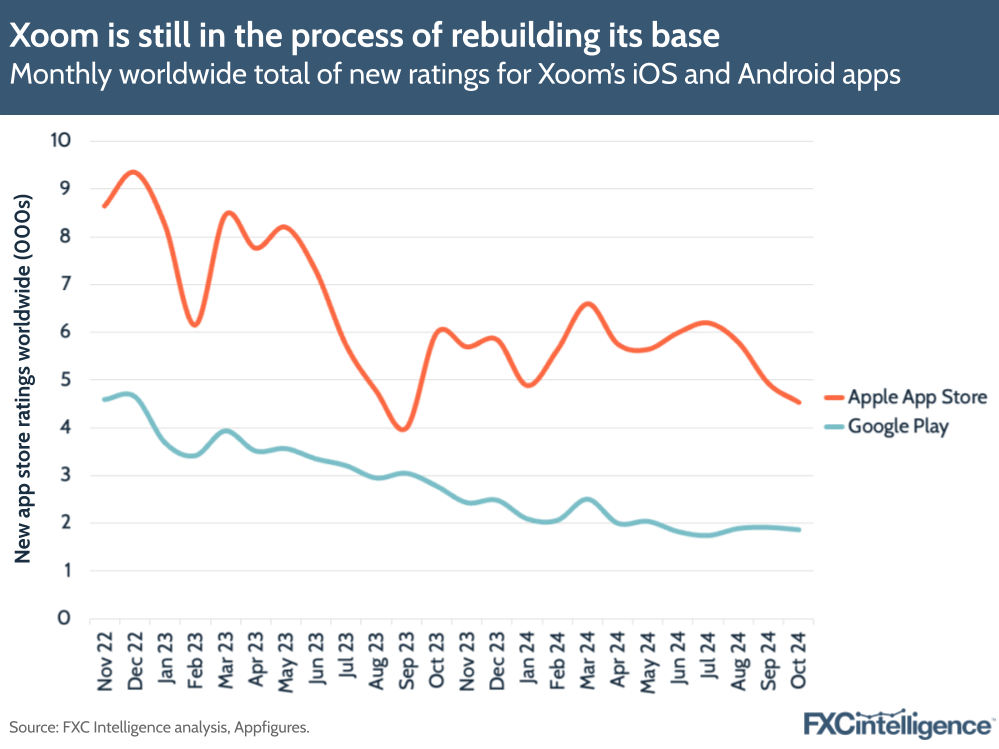
Looking at website visitor data, however, suggests that there has been some improvement for Xoom. SEM Rush data shows that Xoom has been gaining readership in most recent months, with Q3 readership totalling more than a million users more than that of Q1.
This has also allowed it to outperform remittances rival MoneyGram across August and September, although it remains far below the traffic levels of Remitly or Western Union.
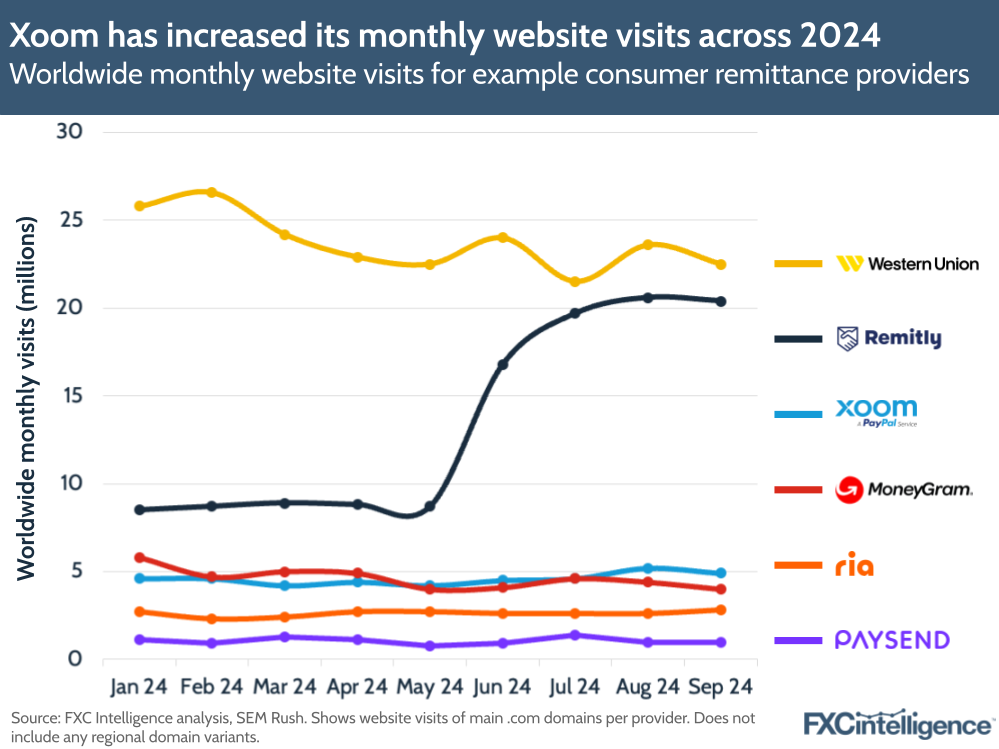
PYUSD and PayPal’s stablecoin strategy
One notable aspect of PayPal’s refocus on Xoom is the introduction of its US dollar-pegged stablecoin PayPal USD (PYUSD). First launched in August 2023, in April of this year PayPal enabled it to be used to fund payments over Xoom. As part of this, the company waived fees associated with the money transfer – one of two elements used to make up the cost of sending the remittance – which we estimated would result in around a 25% cost reduction.
This announcement appears to have played a key role in driving up the amount of PYUSD in circulation, which rose in the months following the announcement. However, there have been other announcements since that are unrelated to P2P payments and that are also likely to have played a role, most notably the addition of PYUSD to the Solana blockchain. This allowed it to be used in a variety of decentralised finance products, including stablecoin lending service Kamino Finance, which in late August raised the global borrowing cap for PYUSD to $20m, a factor that is thought to have contributed to its rising market capitalisation, which briefly passed $1bn.
PYUSD’s circulation remains small compared to Circle’s USDC and Tether’s USDT, however its potential utility for PayPal remains in its infancy. Although not mentioned directly in the latest earnings call, it may well see mention in future discussion as its use grows.In particular, PYUSD is likely to be key to Xoom’s continued expansion, particularly among digital currency users, with recent announcements for the brand led by Jose Fernandez da Ponte, SVP, Blockchain, Crypto and Digital Currencies at PayPal.
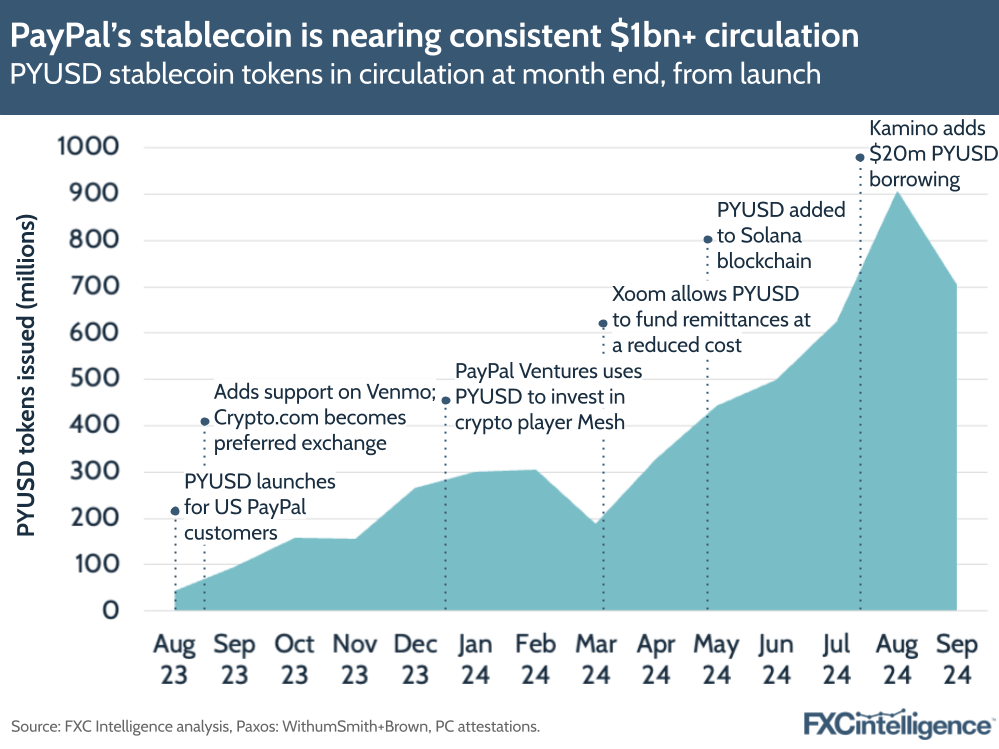
Venmo’s growth and transformation beyond P2P
Beyond Xoom and PayPal’s P2P, US-only Venmo has already seen significant increased focus from its parent company, being a strong topic of discussion in the company’s Q3 2024 earnings call. Totalling $74.8bn TPV in Q3 2024 – 18% of all TPV – Venmo has seen 8% YoY growth on an FX-neutral basis in Q3 2024, a rate it has consistently achieved for the past five quarters.
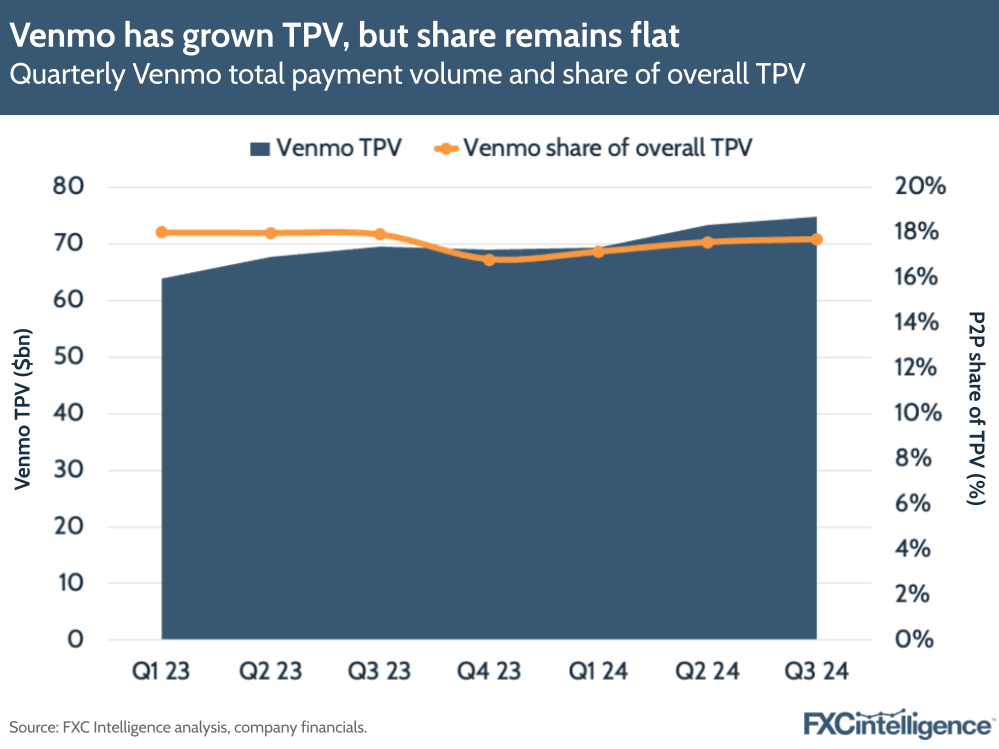
Venmo’s mentions in earnings calls have been particularly elevated over the past few quarters, although were at their highest in Q3 2024. This is because the company outlined how it was “taking a fresh look at Venmo”, according to Chriss, with the ultimate goal of bringing “multiple monetisation levers” to the brand to broaden it beyond its core P2P payments focus and enable it to function more as a fully-featured digital wallet.
This has already seen the launch of a Venmo debit card, an early iteration of which has been available since 2018, but that is still in “the early days of driving adoption”, according to Chriss. In Q3, the company reported that only 5% of monthly active Venmo accounts were active Venmo debit card users, although highlighted that monthly active debit card accounts grew 30% in the quarter. Crucially, average revenue per account is four times higher for debit cards than for overall Venmo accounts, making this a key opportunity for the company.
Pay with Venmo, which allows the platform to be used to make payments online, is also seeing adoption on both the consumer and merchant side, with a 20% increase in the quarter among active users. Here, revenue per account is also higher than Venmo overall, at 3x.
While the company has not yet rolled out details of further plans it has for the brand, Chriss did highlight that the company saw “the brand’s long-term potential as a multibillion-dollar franchise”, which may also indicate an intention to broaden its reach beyond the US.
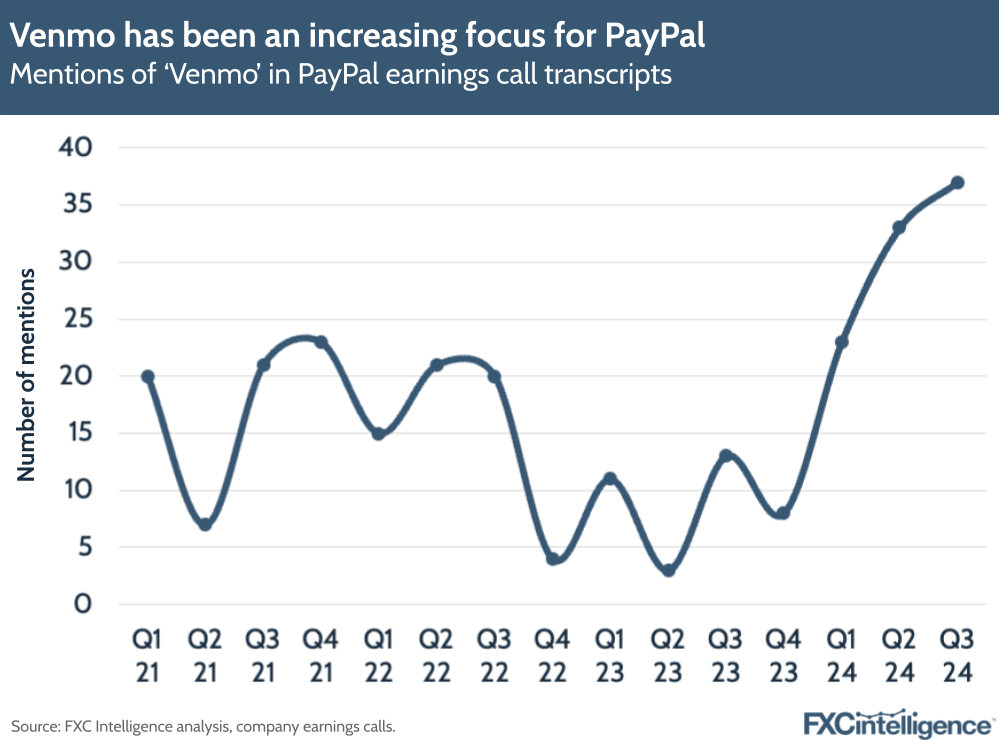
Prospects for PayPal’s Investor Day
The Q3 2024 earnings also saw PayPal announce that it will be holding an Investor Day on 25 February 2025, where it will go into much more detail about future plans and broader strategy for the company.
Much of this is likely to focus around its broadening into a commerce platform, with PayPal likely to expand on many of its recent product launches, particularly around harnessing AI and improving the consumer experience. However, we may see a greater focus on its international offering, and perhaps even more of a regional break-out of how it is thinking about the brand, particularly given there is a far greater opportunity for growth beyond the US than just by focusing on products within it.
However, beyond commerce, we are also likely to see considerable discussion of the company’s P2P offerings. Venmo will undoubtedly get its own focus, likely with discussion about how the company can grow beyond domestic P2P payments and potentially greater metrics about its performance so far.
But P2P excluding Venmo may also see increased discussion, potentially even with some broken out numbers for Xoom, as well as greater clarity on how the company plans to further its growth in this area, particularly when it comes to synergies with its stablecoin play.
P2P payments may not be the central priority, but at 25% of all volume, it’s a very serious contributor for PayPal, and has the potential to be a powerful contributor to the company’s future growth.
Whether PayPal chooses to prioritise it in its Investor Day discussions, however, may ultimately give us a sense of how important the brand considers P2P to its future growth and transformation.



